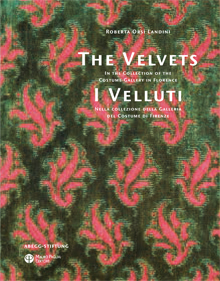Ricerca Veloce
Ricerca Avanzata
chiudi
In this lavishly illustrated, bilingual volume, Roberta Orsi Landini presents a study of Italian velvets based on the collection
In this lavishly illustrated, bilingual volume, Roberta Orsi
Landini presents a study of Italian velvets based on the collection of the
Costume Gallery of the Pitti Palace in Florence. The introductory chapters
address velvet production in Italy, beginning with an explanation of the
process of velvet weaving, followed by detailed descriptions of various weave
structures, accompanied by clear illustrations, allowing the reader to grasp
the highly technical discussions that follow. (At the end of the volume,
further practical information is given in tables and weave diagrams.) Separate
chapters consider the difficult question of attributing velvets to the most
important centres of production (Florence, Lucca, Genoa, Venice, and Milan).
These offer new insights through detailed comparisons between the extant
velvets and legislation promulgated by the silk guilds, with invaluable
illustrations of many different selvedge types. Only the unqualified use of
kermes to denote all of the crimson insect dyes in the velvets could have been addressed
more accurately with reference to the work of Dominique Cardon.
The final chapters are devoted to velvets in the collection of the Costume Gallery. Almost four hundred pieces are catalogued, each one illustrated and presented with a weave analysis and attribution—a formidable achievement. The examples range from the fifteenth century to the early nineteenth, but the main strength of the collection lies in velvets of the mid-sixteenth to the early seventeenth century. The long time span and the abundance of examples allow the reader to follow most of the major developments in velvet weaving. The progression is traced from fabrics that might have served different purposes to clearly demarcated types destined for either furnishing or dress. The discussion of the seventeenth-century Lucchese dress velvets known as contresemplé is particularly illuminating: showing how these voided velvets with small patterns in cut and uncut pile were designed with careful attention to economy of manufacture and to their suitability for tailoring. There is also an interesting consideration of simpler, small-patterned velvets woven on looms without a figure harness.
Excellent illustrations of contemporary paintings enrich the volume, although they are not cited in the text, and there is no index or list of illustrations to help the reader. Among the most evocative images are the photographs of velvets in situ in the grand interiors of the Galleria Doria Pamphilij (Rome) and of Schloss Nymphenburg (Munich).
This outstanding volume will undoubtedly be an essential reference tool for specialists, but it also offers a perfect introduction to the study of velvet, and is beautiful enough to beguile fashion and interior designers.
The final chapters are devoted to velvets in the collection of the Costume Gallery. Almost four hundred pieces are catalogued, each one illustrated and presented with a weave analysis and attribution—a formidable achievement. The examples range from the fifteenth century to the early nineteenth, but the main strength of the collection lies in velvets of the mid-sixteenth to the early seventeenth century. The long time span and the abundance of examples allow the reader to follow most of the major developments in velvet weaving. The progression is traced from fabrics that might have served different purposes to clearly demarcated types destined for either furnishing or dress. The discussion of the seventeenth-century Lucchese dress velvets known as contresemplé is particularly illuminating: showing how these voided velvets with small patterns in cut and uncut pile were designed with careful attention to economy of manufacture and to their suitability for tailoring. There is also an interesting consideration of simpler, small-patterned velvets woven on looms without a figure harness.
Excellent illustrations of contemporary paintings enrich the volume, although they are not cited in the text, and there is no index or list of illustrations to help the reader. Among the most evocative images are the photographs of velvets in situ in the grand interiors of the Galleria Doria Pamphilij (Rome) and of Schloss Nymphenburg (Munich).
This outstanding volume will undoubtedly be an essential reference tool for specialists, but it also offers a perfect introduction to the study of velvet, and is beautiful enough to beguile fashion and interior designers.
Data recensione: 01/01/2019
Testata Giornalistica: Medieval Clothing and Textiles
Autore: Lisa Monnas
